Feb 03 2010
To Oak or Unoak, ‘Tis the Question for Chardonnay

Throughout California, chardonnay grapes are planted abundantly and by the late 1980’s surpassed the number of plantings in France. With so much competition, Chardonnay varies greatly by winemaker and depending on the aging process, the styles can be dizzying: oaked, over-oaked, tannic, unoaked, buttery, flinty, creamy, vanilla, citrus, honey, melon, butterscotch, green apple, nutty, bubblegum … to name a few.
So what makes a good Chardonnay?
Just like with any other wine, balance makes a good Chardonnay. The grape itself is easily manipulated and terrior, climate and style of aging or vinifying can greatly influence the wine. Chardonnays, typically “oaked” in California, over the last several years have started to emerge with popularity as “unoaked”. The terminology is as straight-forward as it sounds. If a winemaker is electing to make its Chardonnay in a “unoaked” style, the wine will be made in stainless steel as opposed to oak. By doing so, the wine is very crisp (often described as “precise”), light and characterized by distinct refreshing minerality.
Unoaked Chardonnay in California is similar to Chardonnay found in the Chablis region of France. Rarely will Chardonnays in the Chablis region go through malolactic fermentation or be exposed to oak barreling. While at first blush this may seem like a simplistic way to make Chardonnay it is generally considered to be the truest and purest expression of the grape itself. Unoaked Chardonnays are fermented only in stainless steel. The result is like those of the Chablis region, simple, straight-forward, clean, crisp, light and generally characterized by green apple, melon or citrus fruit on the palate. With Unoaked Chardonnay you will not find the big creamy, vanilla, toasted oak, or butterscotch notes.
Chardonnay can also be exposed in oak and subjected to malolactic fermentation which perhaps may seem like a traditional Chardonnay to the average connoisseur. These wines are considered to be “Oaked Chardonnay” and depending on how much exposure to the oak and the type of oak (French or American) can greatly affect the flavor, structure and mouth feel of the wine. This style of Chardonnay does typically reflect vanilla, butterscotch, creaminess, oak or butterscotch. All of these elements do not actually come from the grape itself but instead from the oak aging or barreling and exposure to malolactic fermentation (which reduces the natural acidity of the grape). This mainstream sounding style of Chardonnay hails originally from Burgandy, France. And it is also this same style which can run the risk of being flabby, lacking structure and style. If there is too much exposure to oak, the flavor and structure of the wine can be lackluster. Without question, careful winemaking is necessary.
So which one is better?
There is not a definitive answer as to which style of Chardonnay is “better”. The “Unoaked Chardonnay” and the traditional “Oaked Chardonnay” are two separate styles such that the wines almost taste like two separate grapes. It truly does depend on the individual palate, preference and often on the meal being served. To help demonstrate this, a friend provided me with a bottle each of Mer Soleil Vineyard’s (“Mer Soleil”) 2007 “Silver” Chardonnay and its 2007 “Gold” Chardonnay. Mer Soleil’s actual vineyard is located in the Santa Lucia Highlands of Monterey County. It ties back to Napa Valley given that its winemaker is Chuck Wagner II, the son of Chuck Wagner Sr. of famed Caymus Winery (“Caymus”) in Napa Valley. Much like the Caymus philosophy of “one wine, one label”, Mer Soleil focuses only on Chardonnay, producing one unoaked and one oaked. Since Mer Soleil makes quality representation of both styles, it serves as the perfect example to compare and contrast.
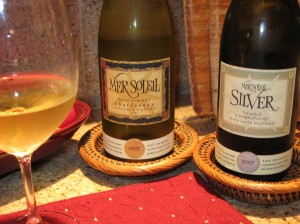
First up is the 2007 Silver Chardonnay. As the bottle opens, the nose is met immediately by refreshing citrus, lemon blossom and green apple aromas. This is a great sign because the wine has not even been poured yet. While opening the bottle, it is noted that its closure is a “screw cap”, which (as discussed in an earlier article) can in some instances better preserve the aromas of the wine. In this case, that is clearly evident. In the glass, the 2007 Silver Chardonnay is much lighter in its gold coloring than a traditionally perceived Chardonnay and if inspected closely, it has a pale green tint. As it greets the palate, a lively acidity is noted along with flavors of honeydew melon, pineapple, a hint of tangerine and a distinct flinty minerality. Immediate carefree sunny afternoon images are triggered, complete with a whimsical oceanic breeze and sunlight dancing upon the Pacific’s waves such that there is nothing on the agenda but lively late afternoon entertaining with good company and light seafood fare such as scallops or a tangy fish taco.
Next up is the 2007 Gold Chardonnay. Opening the bottle, there is not the immediate “greet your nose” experience as with the 2007 Silver Chardonnay, but that does not lessen this wine by any means. Instead, from the moment the bottle is opened, to the wine hitting the glass and your nose thereafter intuitively searching closer, the aromas are present albeit seductively subtle. Coaxing the senses, the aromas of stone fruit, honeysuckle, citrus blossom, lightly toasted oak, spice, and a hint of vanilla greet the nose and beckon the palate to explore. On the palate, nuances of stone fruit continue, with a splash of tangerine, a dash of spice and the accompaniment of a readily present structure (which is a more than pleasant surprise as structure is painfully missing from many California Chardonnays). Yet, perhaps my favorite aspect of this wine is the clear taste of freshly-picked ripe yellow peach on the palate that continues to linger in the wine’s finish long after one’s expectations would have such that one savors and pauses before reaching back for the wine glass. Sitting back to reflect, the 2007 Gold Chardonnay sparkles in dining candlelight reminiscent of sunshine on a late summer wine country afternoon.
Both the 2007 Silver Chardonnay and the 2007 Gold Chardonnay will pair well with food. Reason being, both are balanced wines. While acidity is present in the 2007 Silver Chardonnay, it does not overwhelm the palate and will truly hold up with light seafood dishes without dominating. Thinking of other seafood, such as salmon, and mildly wintery fare which will transition nicely into spring, the 2007 Gold Chardonnay will pair delightfully with this week’s selected menu:
· Phyllo-Wrapped Salmon on a Mushroom Medley with Dijon Vinaigrette
Selecting phyllo dough to wrap the salmon is intentional for flavor. Puff pastry dough is heavier with more butter and given the balanced oak nature of the 2007 Gold Chardonnay, phyllo dough (which is far lighter) is the intuitive paired choice. Brushing the phyllo dough with a butter blend (again to keep the flavors lighter), the skinless boneless salmon is wrapped and then sautéed.
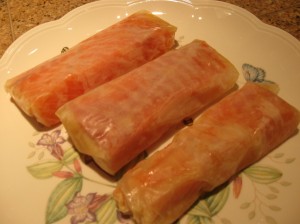
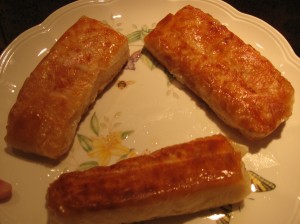
Next prepared is a Mushroom Medley using a blend of porcini, crimini, and button mushrooms. Sautéed first are minced shallot and garlic. Prior to sautéing the mushroom medley, it is roasted in the oven. Once roasted in a butter blend, the mushrooms are next sautéed with some of the 2007 Silver Chardonnay and a combination of freshly picked thyme from the patio, parsley and pepper.
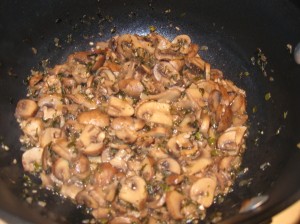
Finally, the Dijon Vinaigrette is prepared incorporating (among other ingredients) the juice of a fresh lime, Dijon mustard, soy sauce, fresh chives from the patio and olive oil.
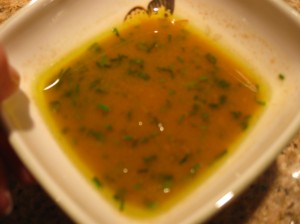
To properly plate, the Salmon is placed atop the Mushroom Medley and drizzled with a bit of the Dijon Vinaigrette.
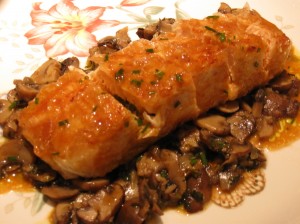
The result is decadent and it electrifies the senses. The combination of the fatty nature of the salmon, the mild buttery flavor of the slightly crisp phyllo dough, the herbs, the wine sautéed mushrooms and the citrus in the Dijon Vinaigrette, equate to sensory overload with a hope that the meal will never end. The 2007 Gold Chardonnay pairs beautifully with this meal since it is balanced and not overwhelmed by big oak and overly buttery flavors. The fresh lime juice in the Dijon Vinaigrette actually accentuates the fruit nuances in the wine. And as each bite finishes, the sip of wine lingers with that light freshly picked ripe peach flavor serving as a natural palate cleanser.
As Napa Valley sits presently in 60 degree temperatures, it is searching for spring amidst the mustard blooms and it is on the cusp of dreaming for warmer weather. Typically ideal for Chardonnay, these temperatures are neither too hot, nor too cold but just right for this style of white wine. Yet open a bottle of Mer Soleil (whether Silver or Gold) and reminisce of everything dreamy that California has to offer because if that could be captured in a bottle, it is here and miraculously in both styles of the wine resulting in the quintessential California Chardonnay.
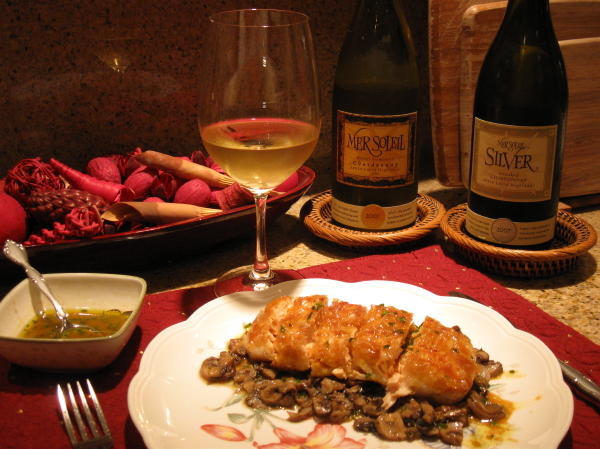
Comments Off on To Oak or Unoak, ‘Tis the Question for Chardonnay